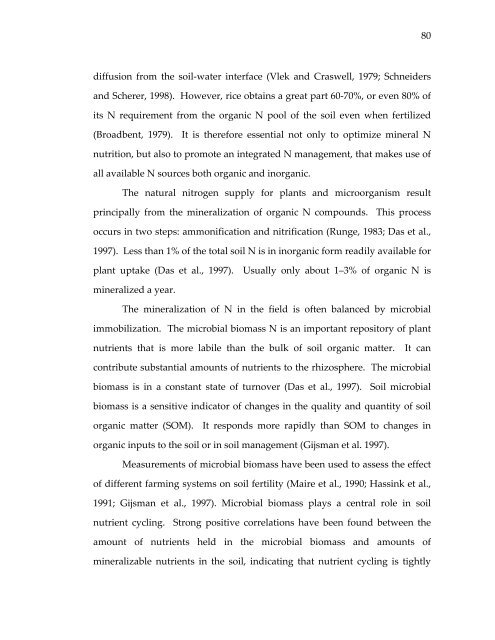Management of rice production systems to increase productivity
Management of rice production systems to increase productivity
Management of rice production systems to increase productivity
You also want an ePaper? Increase the reach of your titles
YUMPU automatically turns print PDFs into web optimized ePapers that Google loves.
diffusion from the soil‐water interface (Vlek and Craswell, 1979; Schneiders<br />
and Scherer, 1998). However, <strong>rice</strong> obtains a great part 60‐70%, or even 80% <strong>of</strong><br />
its N requirement from the organic N pool <strong>of</strong> the soil even when fertilized<br />
(Broadbent, 1979). It is therefore essential not only <strong>to</strong> optimize mineral N<br />
nutrition, but also <strong>to</strong> promote an integrated N management, that makes use <strong>of</strong><br />
all available N sources both organic and inorganic.<br />
The natural nitrogen supply for plants and microorganism result<br />
principally from the mineralization <strong>of</strong> organic N compounds. This process<br />
occurs in two steps: ammonification and nitrification (Runge, 1983; Das et al.,<br />
1997). Less than 1% <strong>of</strong> the <strong>to</strong>tal soil N is in inorganic form readily available for<br />
plant uptake (Das et al., 1997). Usually only about 1–3% <strong>of</strong> organic N is<br />
mineralized a year.<br />
The mineralization <strong>of</strong> N in the field is <strong>of</strong>ten balanced by microbial<br />
immobilization. The microbial biomass N is an important reposi<strong>to</strong>ry <strong>of</strong> plant<br />
nutrients that is more labile than the bulk <strong>of</strong> soil organic matter. It can<br />
contribute substantial amounts <strong>of</strong> nutrients <strong>to</strong> the rhizosphere. The microbial<br />
biomass is in a constant state <strong>of</strong> turnover (Das et al., 1997). Soil microbial<br />
biomass is a sensitive indica<strong>to</strong>r <strong>of</strong> changes in the quality and quantity <strong>of</strong> soil<br />
organic matter (SOM). It responds more rapidly than SOM <strong>to</strong> changes in<br />
organic inputs <strong>to</strong> the soil or in soil management (Gijsman et al. 1997).<br />
Measurements <strong>of</strong> microbial biomass have been used <strong>to</strong> assess the effect<br />
<strong>of</strong> different farming <strong>systems</strong> on soil fertility (Maire et al., 1990; Hassink et al.,<br />
1991; Gijsman et al., 1997). Microbial biomass plays a central role in soil<br />
nutrient cycling. Strong positive correlations have been found between the<br />
amount <strong>of</strong> nutrients held in the microbial biomass and amounts <strong>of</strong><br />
mineralizable nutrients in the soil, indicating that nutrient cycling is tightly<br />
80
















